Press Releases 2020
New funding supports drought predictions in Hawai'i and Pacific Islands
Honolulu, August 21, 2020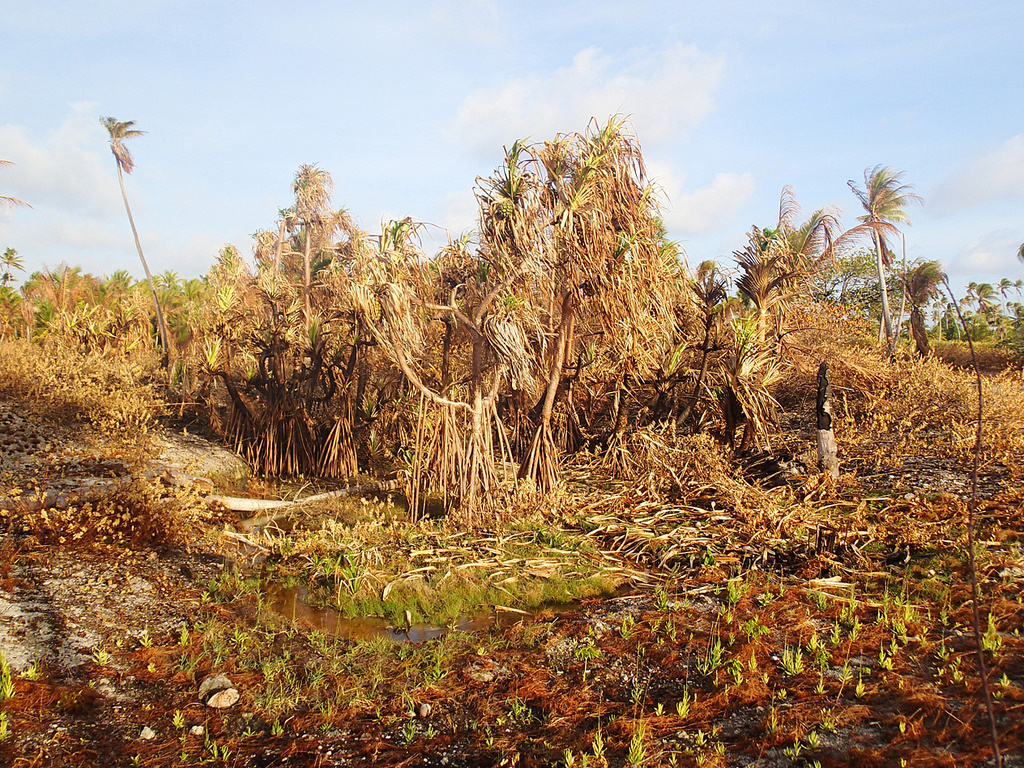
Researchers from IPRC and NOAA secured over $500,000 from NOAA's Modeling, Analysis, Predictions and Projections Program to assess factors affecting the intensity and duration of droughts over Hawai'i and U.S.-affiliated Pacific Islands (USAPI) and develop seasonal predictions of rainfall, including floods and droughts. During the three years of the award, IPRC senior researcher Hariharasubramanian (Anna) Annamalai, Arun Kumar with the Climate Prediction Center at NOAA, Maryland, and John Marra, director of Climate Services for the Pacific Islands at NOAA, Honolulu, will build on the seasonal predictions of rainfall, floods and droughts over Hawai'i and USAPI they have been working on for over a decade. Read the press release for more details.
New study shows the global atmosphere rings like a bell
Honolulu, July 6, 2020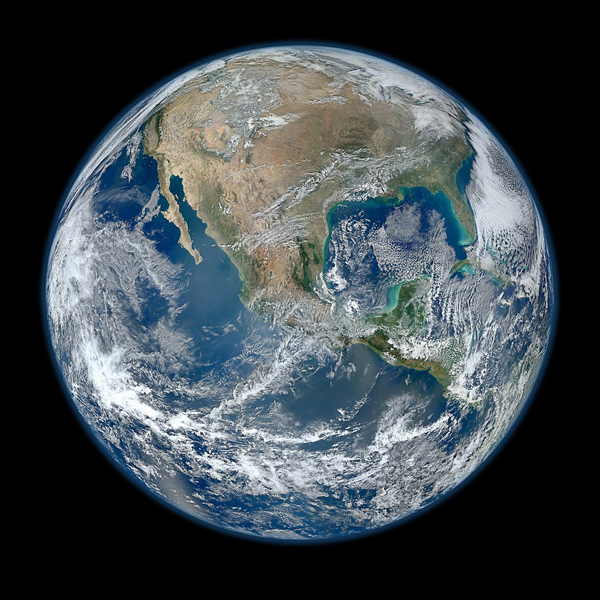
A recent study shows that the Earth's entire atmosphere vibrates like a ringing bell, in a striking confirmation of theories developed by physicists over the last two centuries. Takatoshi Sakazaki, a former IPRC post-doc and now an assistant professor at the Kyoto University Graduate School of Science, and Kevin Hamilton, an Emeritus Professor in the Department of Atmospheric Sciences and IPRC, use 38 years' worth of atmospheric pressure observations to reveal the presence of dozens of predicted wave modes. For more details, read this press release or the paper itself at the Journal of the Atmospheric Sciences. This work was featured in stories in The Atlantic and in Physics World.
Expedition to remove debris from Great Pacific Garbage Patch begins
Honolulu, May 15, 2020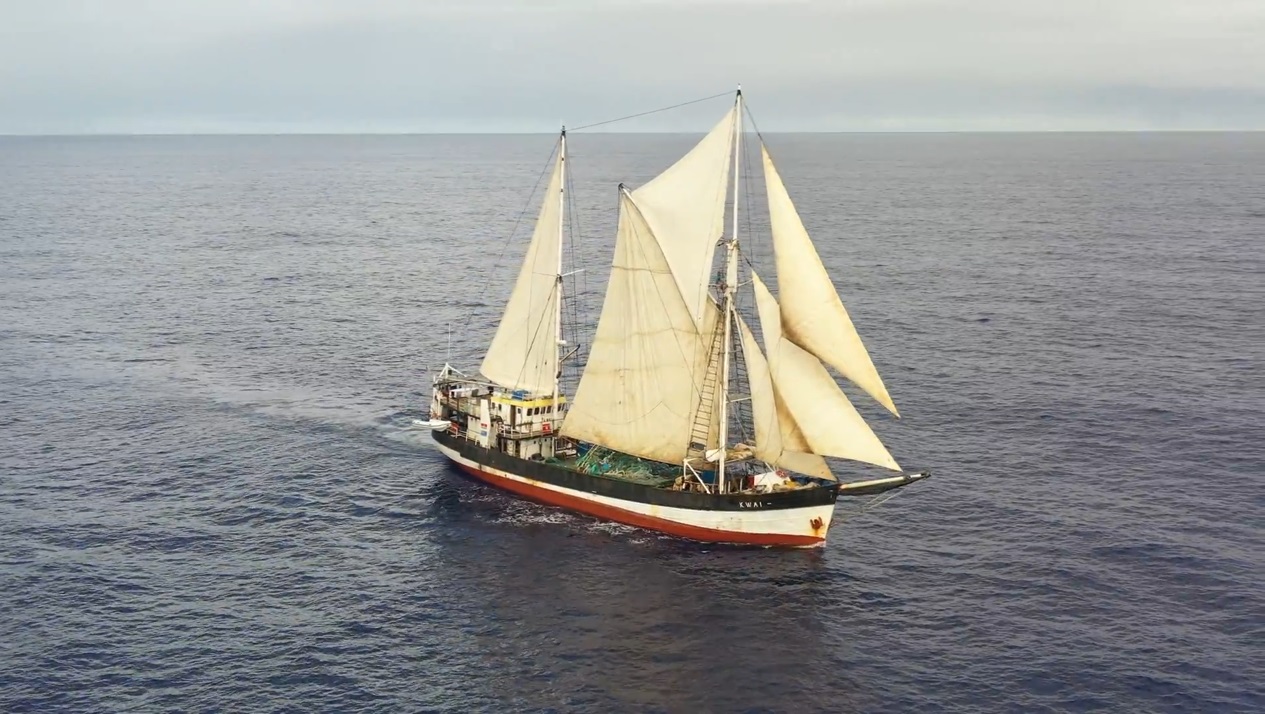
Nikolai Maximenko, researcher with SOEST's International Pacific Research Center, is leading a NASA-funded project FloatEco supporting a collaboration with Ocean Voyages Institute, Smithsonian Environmental Research Center, Lagrangian Drifter Laboratory at Scripps Institution of Oceanography, Applied Physics Laboratory at University of Washington, Williams College, and Fisheries and Oceans Canada to recover floating debris in the Great Pacific Garbage Patch and to study physical and biological processes controlling the ecosystem based on this debris. For more details, read the press release here or in The Maritime Executive
Press Releases 2019
IPRC leads study that shows climate warming promises more frequent extreme El Niño events
Honolulu, October 21, 2019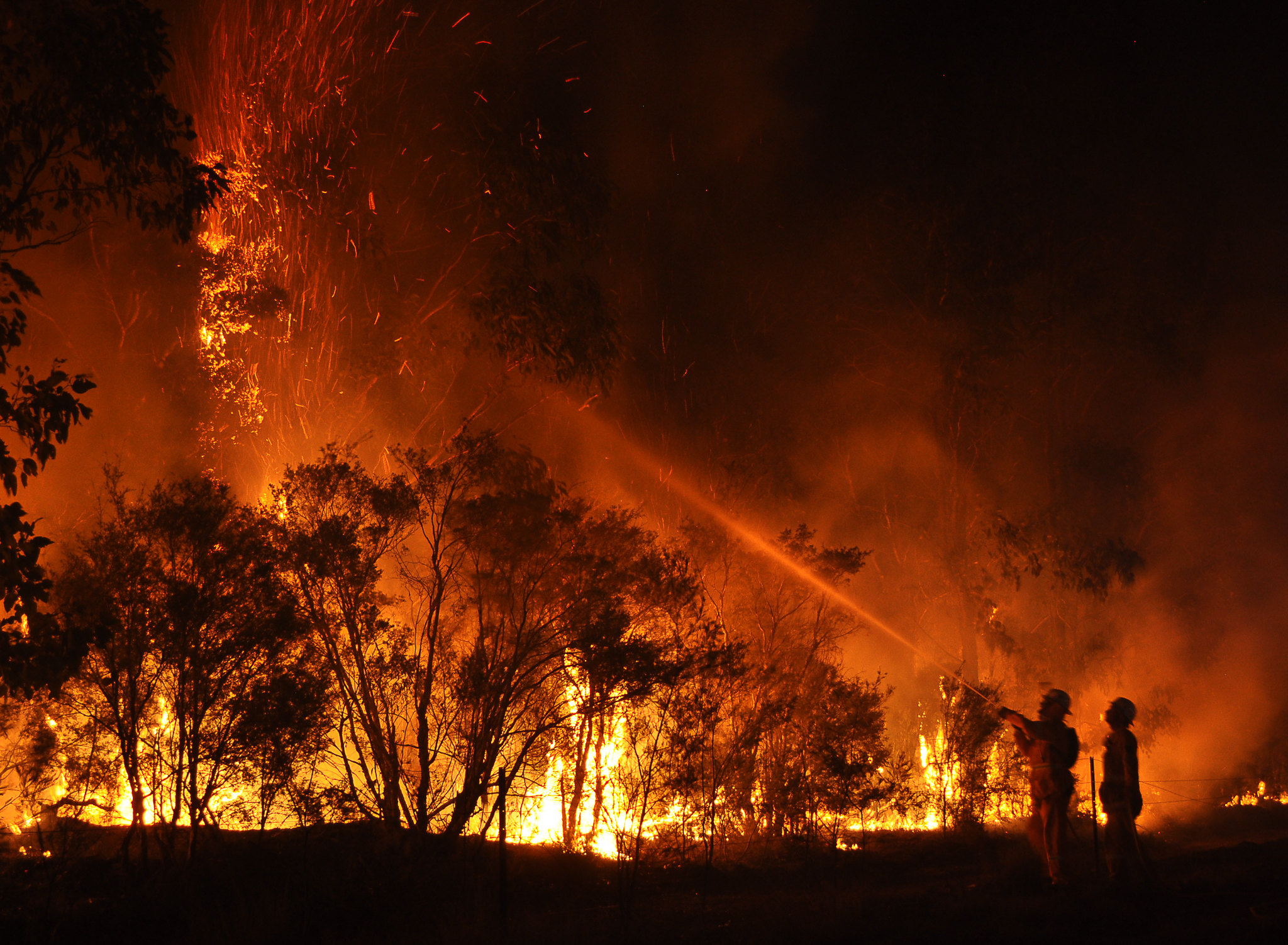
An important question that researchers have looked to answer is how climate change is affecting El Niño events, their frequency and strength. IPRC's Bin Wang led an international groups of climate scientists in an effort to answer this question. By examining 33 historical El Niño events since 1901, they found distinct shifts in behavior since climate warming became more pronounced in the 1970's which suggest more extreme events are in our future if warming continues. Read more details in this press release, this UH News story, or the paper at PNAS.
Press Releases 2018
IPRC researchers establish link between hiatus conditions and increased numbers of intense cyclones in northwestern Pacific Ocean
Honolulu, April 27, 2018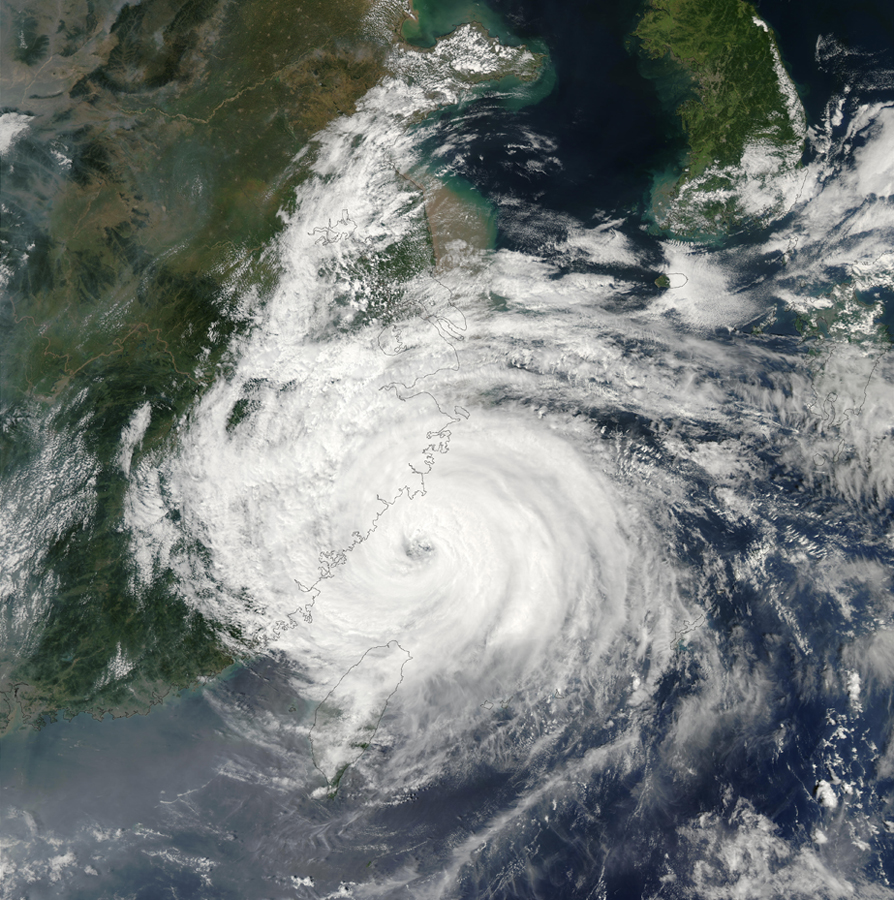
In recent decades, there has been an unexpected increase in the intensity and frequency of strong tropical cyclones in the northwestern region of the Pacific Ocean, along the coastline of East Asia. IPRC visiting researchers Jiuwei Zhao and Ruifen Zhan, led by IPRC's Yuqing Wang, published a study recently in Scientific Reports showing a strong correlation between conditions during the Global Warming Hiatus of 1998-2012 and the increased numbers and strengths of cyclones in the region during that period. Conditions during the Hiatus mimicked those typical of La Niña events, with sea surface temperatures and wind patterns promoting formation, intensification, and landfall of cyclones in the far northwestern Pacific Ocean. Read more details of their study in this press release or their published paper.
Low-lying Pacific Islands may become uninhabitable sooner than previously thought
Honolulu, April 25, 2018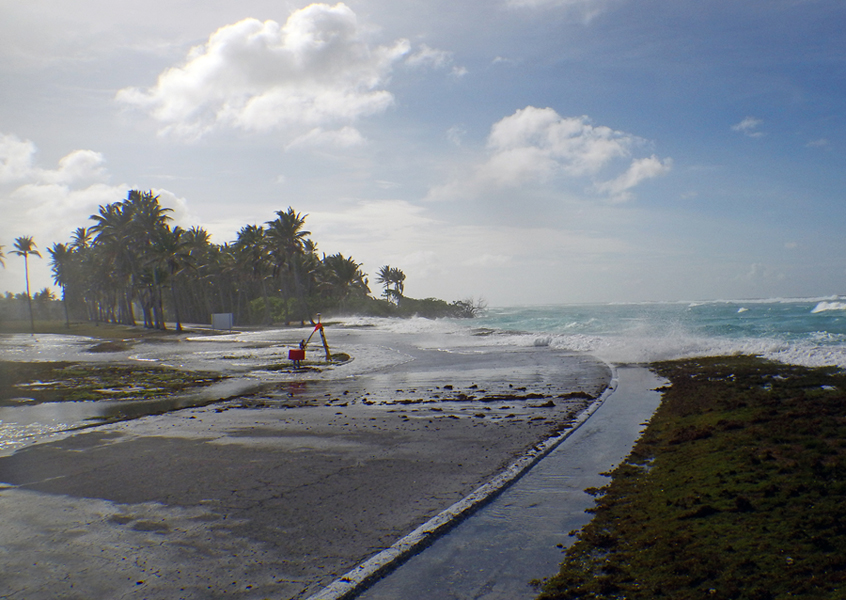
A new study published today looks at island habitability in a new light and has some troubling results. It has been known for years that low-lying atoll islands are threatened by sea level rise, and previous estimates have been made suggesting that by the end of the century, sea level will be high enough that atolls will become inundated. However, this new study, with climate modeling contributions from IPRC's H. Annamalai and Matthew Widlansky, considers the effects of wave action in addition to elevated sea levels. Projections of wave-driven flooding suggest freshwater resources on these islands will be irrevocably contaminated by mid-century (2030-2060), which, when combined with repeated damage to infrastructure, would render Pacific atolls uninhabitable. Read more details in this press release, or in the published paper.
Press Releases 2017
IPRC modelers examine the future of snow in Hawai‘i
Honolulu, May 2, 2017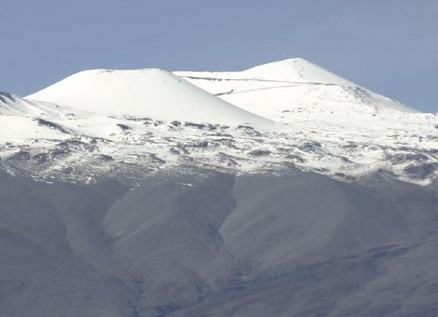
Thoughts of Hawai‘i tend to conjure images of sun-soaked beaches and waving palms, not snow. However, on the highest peaks in the state, Mauna Kea and Mauna Loa on Hawai‘i Island, winter often generates a blanketing of snow for at least a few days a year. IPRC's Chunxi Zhang found that despite the local aesthetic and economic value of the snow, there was viturally no systematic observations of this snow activity. With Kevin Hamilton and Yuqing Wang, he developed a new daily index of snow cover on the mountains from examination of satellite spectral imagery from 2000 to 2015. Using that data for groundtruthing, he modeled the future of Hawai‘i's mountain snow. Read more in the press release. Read a short piece about the study in the local Hawaii Tribune Herald.
IPRC researchers turn to the upper atmosphere to explain tropical rainfall patterns
Honolulu, February 9, 2017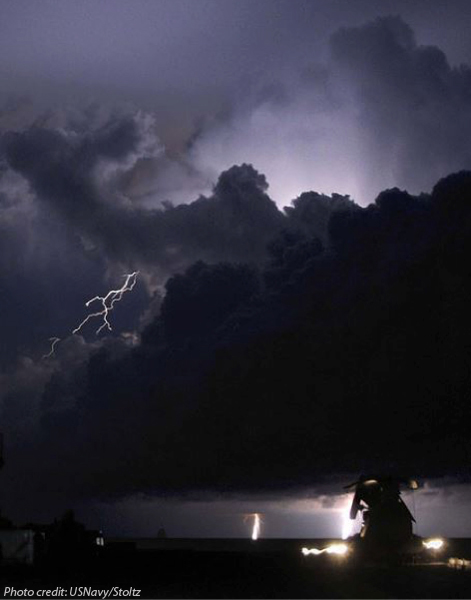
With the threat of changing precipitation patterns across the globe, it has become increasingly important to understand what governs the rainfall patterns we see today. A team of IPRC climate modelers, led by postdoctoral researcher Takatoshi Sakazaki, has investigated what causes a tropical rainfall abundance pattern of two distinct peaks, 12 hours apart. The results of the study, recently published online at Geophysical Research Letters, suggest that the temporal pattern is attributable to a well-known phenomenon called an "atmospheric tide." A global pressure wave daily develops in the upper atmosphere, driven by sunlight heating of the ozone layer, and propagates downward to the land surface below. Rainfall concentrates during low-pressure periods. Read more in the press release. Sakazaki's work also got a nod in the Minneapolis Star-Tribune's weather blog (scroll about half-way down). Watch an appearance of Sakazaki and co-author Kevin Hamilton on Think Tech Hawaii.
Press Releases 2016
IPRC study finds a warmer climate is more sensitive to CO2 changes
Honolulu, November 9, 2016 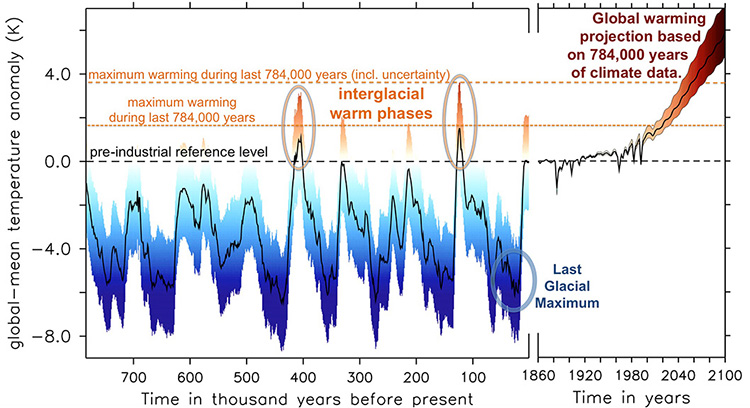
Scientists have understood for a long time that carbon dioxide acts to trap solar energy as heat in the atmosphere. But according to a new study led by Tobias Friedrich, an IPRC post-doctoral researcher, and Axel Timmermann, Professor of Oceanography, the amount of heating due to an increase in CO2 depends on how warm the climate already is. By reconstructing temperatures and CO2 levels on Earth for the past 784,000 years, Friedrich was able to determine how the atmosphere reacted to previous changes in the system. His results suggest that as the climate gets warmer, it becomes more sensitive to changes in CO2. As our planet is currently in a warmer, interglacial phase, this may have significant implications for how the climate will continue to respond to anthropogenic CO2 increases. Read more details in the press release here. Or read their abstract and paper here.
IPRC modelers use climate to deduce likely timing of human migration
Honolulu, September 21, 2016 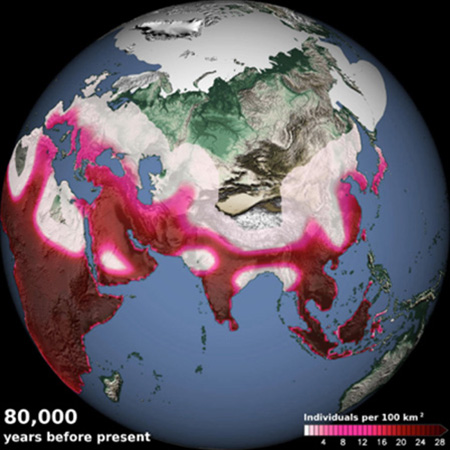
The spread of the human species, anchored and radiating out from Africa to migrate around the globe, has occurred in waves over many millennia. However, when the first small groups ventured out of Africa is subject to debate. New results published in the journal Nature by IPRC researchers Axel Timmermann and Tobias Friedrich integrate climate models with human migration models to determine the most likely timeframe for human dispersal based on the influence of changing climate patterns. Read more about their compelling results in the press release, or the original journal abstract, and view a short explanatory video at vimeo or on youtube. Read how their study relates to new genetic models of human migration here. Or listen to a different take in a Nature Podcast (starting at 16:14).
IPRC scientists aid international study on unexpected changes in high-level equatorial winds
Honolulu, September 8, 2016 
No one likes a disruption in their routine, least of all scientists. In February of this year, though, one of the most repeatable, predictable phenomena of atmospheric winds threw scientists for a loop by breaking its long-standing pattern. High altitude (16-50 km) equatorial winds typically oscillate between prevailing eastward and westward wind-jets, with a period of about 2-3 years, creating a pattern referred to as the Quasi-Biennial Oscillation (QBO). But in February, the unexpected occurred: the pattern changed. IPRC scientists Kevin Hamilton, recently retired Professor of Atmospheric Sciences, and Chunxi Zhang, Atmospheric Modeling Specialist, worked with Scott Osprey of the National Centre for Atmospheric Science at the University of Oxford and an international team to study the unexpected disruption. Read more in an IPRC press release here and in the Oxford press release.
Press Releases 2015
IPRC group shows rapidly acidifying waters pose major threat for Southern Ocean ecosystem
Honolulu, November 2, 2015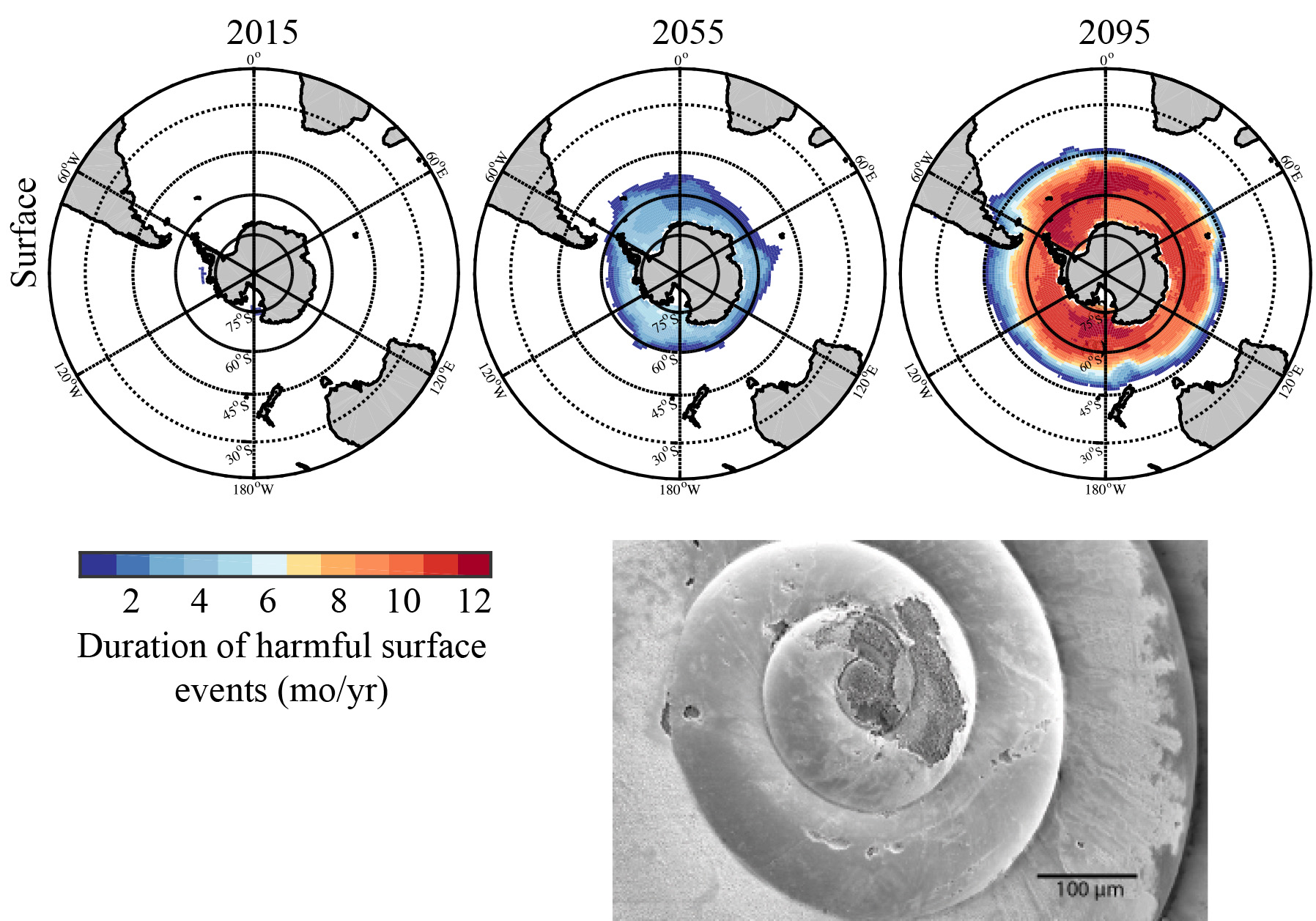
As a result of increasing atmospheric carbon dioxide concentrations, the chemistry of the Southern Ocean is expected to change so fast over the next few decades that small, but important, creatures at the base of the food web may soon struggle to form their carbonate shells. For some organisms the onset of such critical conditions will be so abrupt, and the duration of events so long, that adaption may become impossible, according to new research by Claudine Hauri, at both the International Artic Research Center (IARC) at the University of Alaska, Fairbanks and the IPRC, in collaboration with Tobias Friedrich and Axel Timmermann of IPRC. Read more in the press release, or the original journal article, and view an explanatory video here. Visit an article here at The Age. Read the story at IARC and at the Ocean Acidification International Coordination Center (OA-ICC). Hear an interview with Axel Timmermann by Radio New Zealand. Hear a new interview with Claudine Hauri by Fairbank's Changing Artic, and read a Q&A with Claudine at the Ocean Conservancy blog.
New model by IPRC researchers explains near-annual Monsoon patterns generated by El Niño
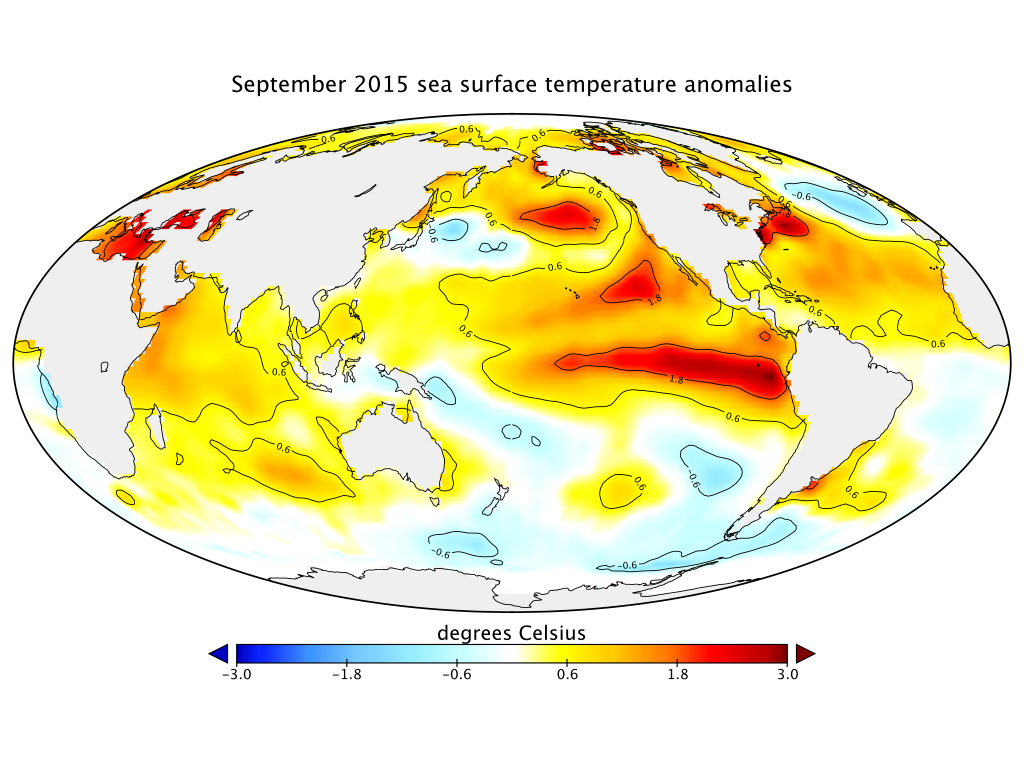
Honolulu, October, 19, 2015
The El Niño Southern Oscillation (called ENSO) is one of the most prominent climate events on the globe. Every two to seven years, temperature shifts cause modifications in wind and rainfall patterns in the Pacific, triggering changes in the climate around the world. A new study by Malte Stuecker and Fei-Fei Jin from Department of Atmospheric Sciences in collaboration with Axel Timmermann from IPRC present a new methodology which explores how interaction of the El Niño phenomenon with the annual cycle of solar radiation in the western Pacific generates a suite of predictable wind and rainfall patterns associated with the Southeast Asian Monsoons. In contrast to the inter-annual timescales of El Niño, monsoon oscillations occur on nearly annual timescales. The methodology provides a new way to explore atmosphere variability, as well as a number of other climate phenomena. Read the press release for more details.
IPRC Scientists show Frequency of El Niño-generated Sea Level Extremes to Increase with Effects of Climate Change
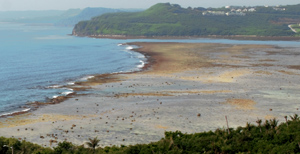
Honolulu, September 25, 2015
Gradual sea-level rise due to climate-induced melting of world-wide ice deposits is a well-known scenario at this stage, and many island nations in the tropical Pacific are already coping with the reality of an encroaching ocean. However, recent modeling research by IPRC scientists Matthew Widlansky and Axel Timmermann suggest that more frequent and extreme short-term sea level fluctuations may soon become an additional challenge. The new model incorporates the effects of a warming planet on the El Niño-La Niña phenomenon. The results show that intensified winds will double the frequency of the sea level fluctuations associated with these global weather patterns, particularly affecting the tropical southwestern Pacific. Read the press release for more details. (Photo credit: Mark Lander, University of Guam)
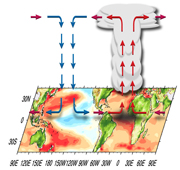
Extending climate predictability beyond El Niño
Honolulu, April 21, 2015
Tropical Pacific climate variations and their global weather impacts may be predicted much further in advance than previously thought, according to research by IPRC's Yoshimitsu Chikamoto and Axel Timmermann and their international colleagues in the USA, Australia, and Japan. The source of this predictability lies in the tight interactions between the ocean and the atmosphere and among the Atlantic, the Pacific and the Indian Oceans. Such long-term tropical climate forecasts are useful to the public and policy makers. Read press release.
Press Releases 2014
Warmest oceans ever recorded
Honolulu, November 13, 2014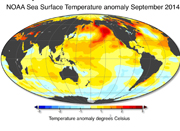
"This summer has seen the highest global mean sea surface temperatures ever recorded since their systematic measuring started. Temperatures even exceed those of the record-breaking 1998 El Niño year," says IPRC's climate scientist and professor Axel Timmerman.
"From 2000-2013 the global ocean surface temperature rise paused, in spite of increasing greenhouse gas concentrations. As of April 2014 ocean warming, however, has picked up speed again. Read press release. Read New Scientist.
Atlantic origin of recent Pacific trade wind, sea level, and temperature trends
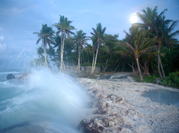
August 14, 2014
IPRC's Axel Timmermann and Yoshimitsu Chikamoto partnered with colleagues at the University of New South Wales and University of Hawaii to solve the puzzle of why, contrary to climate model projections, observations show that in recent years the Pacific trade winds have strengthened, the eastern Pacific has cooled, and sea level has risen in the western Pacific. The source of these trends, they have found, is rapid warming of the Atlantic Ocean. Read release.
What is El Niño Taimasa?
Honolulu, February 20, 2014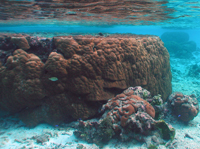
During very strong El Niño events, sea level drops abruptly in the tropical western Pacific and tides remain below normal for up to a year in the South Pacific, especially around Samoa. The Samoans call the wet stench of coral die-offs arising from the low sea levels taimasa (pronounced [kai' ma'sa]). The international study to uncover the reasons for this phenomenon and its climate effects, was spearheaded by IPR's Matthew Widlansky and published in the Journal of Climate. Widlansky will speak at Ocean Sciences 2014 on the topic. Read more in
press release.
IPRC Ocean Drift Model supports castaway fisherman's journey
Honolulu, February 13, 2014
 The IPRC Ocean Drift Model developed by Nikolai Maximenko and Jan Hafner and used to track tsunami debris from Japan supports the improbable account of Jose Salvador Alvarenga, a Salvadoran fisherman, who says he survived more than a year adrift at sea before his boat washed ashore in the Marshall Islands. The 16 paths simulated in the model follow a
remarkably narrow path over this long period of time toward and beyond Ebon Atoll, not more than about 120 miles apart. Click here or image for animation. Read more in press release.
The IPRC Ocean Drift Model developed by Nikolai Maximenko and Jan Hafner and used to track tsunami debris from Japan supports the improbable account of Jose Salvador Alvarenga, a Salvadoran fisherman, who says he survived more than a year adrift at sea before his boat washed ashore in the Marshall Islands. The 16 paths simulated in the model follow a
remarkably narrow path over this long period of time toward and beyond Ebon Atoll, not more than about 120 miles apart. Click here or image for animation. Read more in press release.
Press Releases 2013
Where Will Debris from Super Typhoon Haiyan Go in the Ocean?
Honolulu, November 22, 2013
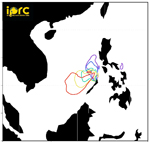 Using the model developed for the 2011 tsunami debris, IPRC’s Nikolai Maximenko and Jan Hafner are projecting paths for the debris that might have been generated by super typhoon Haiyan in the Philippines. According to the model, any typhoon-generated marine debris is expected to move westward through the Philippine Archipelago into the South China Sea. Unclear is whether from there it would be carried to the coasts of Vietnam or would be diverted by currents and winds to different shores of the South China Sea. Read press release.
Using the model developed for the 2011 tsunami debris, IPRC’s Nikolai Maximenko and Jan Hafner are projecting paths for the debris that might have been generated by super typhoon Haiyan in the Philippines. According to the model, any typhoon-generated marine debris is expected to move westward through the Philippine Archipelago into the South China Sea. Unclear is whether from there it would be carried to the coasts of Vietnam or would be diverted by currents and winds to different shores of the South China Sea. Read press release.
El Niño Is Becoming More Active
Honolulu, October 28, 2013
 A new approach to analyzing paleo-climate reconstructions of the El Niño Southern Oscillation (ENSO) phenomenon resolves disagreements and reveals that ENSO activity during the 20th century has been unusually high compared to the past 600 years. The study, published in Climate of the Past, was co-authored by IPRC's Axel Timmermann and by Shayne McGregor and colleagues at the University of New South Wales and at the NOAA Geophysical Fluid Dynamics Laboratory.Read press release.
A new approach to analyzing paleo-climate reconstructions of the El Niño Southern Oscillation (ENSO) phenomenon resolves disagreements and reveals that ENSO activity during the 20th century has been unusually high compared to the past 600 years. The study, published in Climate of the Past, was co-authored by IPRC's Axel Timmermann and by Shayne McGregor and colleagues at the University of New South Wales and at the NOAA Geophysical Fluid Dynamics Laboratory.Read press release.
Honolulu, July 1, 2013
Reliable prediction of El Niño response to global warming is difficult, as El Niño varies naturally over decades and centuries. Instrumental records are too short to determine whether recent changes are natural or attributable to increased greenhouse gases. An international team of scientists, spearheaded by Jinbao Li and Shang-ping Xie while at the IPRC, now shows that recent El Niño activity is the highest for the past 700 years, possibly a response to global warming. The work is published in the June 30, 2013, online issue of Nature Climate Change. Read press release.
Climate researchers find new rhythm for El Niño
Honolulu, May 26, 2013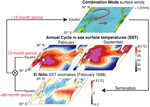 Why El Niño peaks in boreal winter and ends quickly in February to April has been a long-standing mystery. The answer lies in an interaction between El Niño and the annual cycle that generates an unusual wind pattern in the tropical Pacific with a 15-month period, according to a study by IPRC's Axel Timmermann and Malte Stuecker and Fei-Fei Jin at the UH Manoa Meteorology Department. The study that may lead to improved El Niño Forecasting was published in the May 26 online issue of Nature Geoscience. Read press release.
Why El Niño peaks in boreal winter and ends quickly in February to April has been a long-standing mystery. The answer lies in an interaction between El Niño and the annual cycle that generates an unusual wind pattern in the tropical Pacific with a 15-month period, according to a study by IPRC's Axel Timmermann and Malte Stuecker and Fei-Fei Jin at the UH Manoa Meteorology Department. The study that may lead to improved El Niño Forecasting was published in the May 26 online issue of Nature Geoscience. Read press release.
The Tropical Upper Atmosphere "Fingerprint" of Global Warming
Honolulu, May 23, 2013
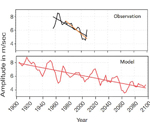 The winds of the quasibiennial oscillation in the tropical upper atmosphere have greatly weakened at some altitudes over the last six decades, according to a study by IPRC's Kevin Hamilton and JAMSTEC's Yoshio Kawatani. The finding, published in the May 23, 2013, issue of Nature, is consistent with computer model projections of how the upper atmosphere responds to global warming induced by increased greenhouse gas concentrations. Read IPRC press release; read JAMSTEC press release; and read article.
The winds of the quasibiennial oscillation in the tropical upper atmosphere have greatly weakened at some altitudes over the last six decades, according to a study by IPRC's Kevin Hamilton and JAMSTEC's Yoshio Kawatani. The finding, published in the May 23, 2013, issue of Nature, is consistent with computer model projections of how the upper atmosphere responds to global warming induced by increased greenhouse gas concentrations. Read IPRC press release; read JAMSTEC press release; and read article.
Sea level impact on Indo-Pacific climate during glacial times
Honolulu, May 19, 2013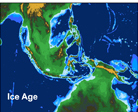 Pedro DiNezio of the International Pacific Research Center, University of Hawaii at Manoa, and Jessica Tierney, Woods Hole Oceanographic Institution, investigated preserved geological clues (called "proxies") of rainfall patterns during the last ice age when the planet was dramatically colder than today. Comparing these patterns with computer model simulations, they found that the exposed Sunda Shelf during the last ice age shifted rainfall and convection westward.
Read press release.
Pedro DiNezio of the International Pacific Research Center, University of Hawaii at Manoa, and Jessica Tierney, Woods Hole Oceanographic Institution, investigated preserved geological clues (called "proxies") of rainfall patterns during the last ice age when the planet was dramatically colder than today. Comparing these patterns with computer model simulations, they found that the exposed Sunda Shelf during the last ice age shifted rainfall and convection westward.
Read press release.
More Hurricanes for Hawaii?
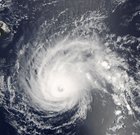
Honolulu, May 5, 2013
Hawaii, fortunately, has been largely free of hurricanes in the recent past, only two having made landfall in more than 30 years.
Now a study headed by IPRC's Hiroyuki Murakami shows that more tropical cyclones may come close to Hawaii by the last quarter of this century. The study appears in the May 5, 2013, online issue of Nature Climate Change. Read press release.
Less rainfall expected for the Hawaiian Islands
Honolulu, April 23, 2013
 Almost imperceptibly, rainfall over the Hawaiian Islands has been declining since 1978, and this trend is likely to continue with global warming through the end of this century, according to a team of scientists by IPRC's Oliver Elison Timm and colleagues at the University of Hawaii at Manoa (UHM) and the University of Colorado at Boulder. The study appeared in the March 13, 2013, early online issue of the Journal of Geophysical Research. Read press release.
Almost imperceptibly, rainfall over the Hawaiian Islands has been declining since 1978, and this trend is likely to continue with global warming through the end of this century, according to a team of scientists by IPRC's Oliver Elison Timm and colleagues at the University of Hawaii at Manoa (UHM) and the University of Colorado at Boulder. The study appeared in the March 13, 2013, early online issue of the Journal of Geophysical Research. Read press release.
Study reveals seasonal patterns of tropical rainfall changes from global warming

Honolulu, April 15, 2013
Projections of rainfall changes from global warming have been very uncertain because scientists could not determine how two different mechanisms will impact rainfall. The two mechanisms turn out to complement each other and together shape the spatial distribution of seasonal rainfall in the tropics, according to IPRC's Shang-Ping Xie and colleagues in China, who published their study in the April 14, 2013, online issue of Nature Geoscience.
Read press release.
Natural Climate Swings Contribute More than Global Warming to Increased Monsoon Rainfall

Honolulu, March 21, 2013
An international team of scientists around IPRC's Bin Wang found that over the past 30 years the Northern Hemisphere summer monsoon circulation has substantially intensified, resulting in significantly more global summer monsoon rainfall than predicted from greenhouse-gas-induced warming alone. Much of this intensification is attributable to natural long-term swings in ocean surface temperatures, especially to a cooling in the eastern Pacific. The study is published in the March 18, 2013, Proc Natl Acad Sci USA. Read press release.
The Complexity of Global Warming:Greenhouse Gases Versus Solar Heating
Honolulu, January 30, 2013
 Examining global precipitation changes over the last millennium and projections to the end of the 21st century in computer climate simulations, a team of scientists led by Jian Liu (Chinese Academy of Sciences) and Bin Wang (International Pacific Research Center, University of Hawaii at Manoa), found that global warming from greenhouse gases affects rainfall patterns in the world differently than that from solar heating. Read press release.
Examining global precipitation changes over the last millennium and projections to the end of the 21st century in computer climate simulations, a team of scientists led by Jian Liu (Chinese Academy of Sciences) and Bin Wang (International Pacific Research Center, University of Hawaii at Manoa), found that global warming from greenhouse gases affects rainfall patterns in the world differently than that from solar heating. Read press release.
Breakthrough in Predicting Asian Summer Monsoon Rainfall
Honolulu, January 22, 2013
 A team of scientists, led by IPRC's Bin Wang, has made a breakthrough for predicting in spring both the summer monsoon rainfall over East Asia and the tropical storm activity near East Asian coastal areas. These two weather phenomena are controlled by fluctuations in the Western Pacific Subtropical High, a major atmospheric circulation system centered over the Philippine Sea. The study was published online on January 21 in the Proceedings of the Academy of Sciences. Read press release.
A team of scientists, led by IPRC's Bin Wang, has made a breakthrough for predicting in spring both the summer monsoon rainfall over East Asia and the tropical storm activity near East Asian coastal areas. These two weather phenomena are controlled by fluctuations in the Western Pacific Subtropical High, a major atmospheric circulation system centered over the Philippine Sea. The study was published online on January 21 in the Proceedings of the Academy of Sciences. Read press release.
Press Releases 2012
Tropical Indo-Pacific Climate Shifts to a More El Niño-Like State
Honolulu, November 14, 2012
 Climate models predict a slowdown of the Walker circulation with global warming. Atmospheric models, however, have failed to reproduce the slowdown already observed over the last 60 years, casting doubt on their ability to simulate slow climate change. Now a study spearheaded by IPRC's Hiroki Tokinaga in this week's issue of Nature has succeeded in simulating the slowdown and shows that changes in the sea surface temperature pattern across the Indo-Pacific are the cause. Read press release.
Climate models predict a slowdown of the Walker circulation with global warming. Atmospheric models, however, have failed to reproduce the slowdown already observed over the last 60 years, casting doubt on their ability to simulate slow climate change. Now a study spearheaded by IPRC's Hiroki Tokinaga in this week's issue of Nature has succeeded in simulating the slowdown and shows that changes in the sea surface temperature pattern across the Indo-Pacific are the cause. Read press release.
Uncertainty of Future Pacific Island Rainfall Explained
Honolulu, October 28, 2012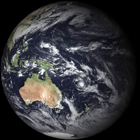 With greenhouse warming, rainfall in the South Pacific islands will depend on two competing effects – an increase due to overall warming and a decrease due to changes in atmospheric water transport – according to a study by an international team of scientists around IPRC's Matthew Widlansky and Axel Timmermann. In the South Pacific, these two effects sometimes cancel each other out, resulting in highly uncertain rainfall projections. Results of the study are published in the 28 October online issue of Nature Climate Change. Read press release.
With greenhouse warming, rainfall in the South Pacific islands will depend on two competing effects – an increase due to overall warming and a decrease due to changes in atmospheric water transport – according to a study by an international team of scientists around IPRC's Matthew Widlansky and Axel Timmermann. In the South Pacific, these two effects sometimes cancel each other out, resulting in highly uncertain rainfall projections. Results of the study are published in the 28 October online issue of Nature Climate Change. Read press release.
Department of Interior Awards Over One Million Dollars to UH Manoaand Hilo for Climate Studies

Honolulu, October 10, 2012
Today Interior Secretary Ken Salazar announced the funding for the 69 nationwide projects of the recently established Climate Science Centers. Among the 5 projects funded for the Pacific Islands Climate Science Center are two spearheaded by IPRC scientists: Climate Change Research in Support of Hawaiian Ecosystem Management: An Integrated Approach, led by Oliver Elison Timm, and 21st Century High-Resolution Climate Projections for Guam and American Samoa, led by Yuqing Wang. Read press release.
Earlier Monsoon Onset Impacts Tropical Cyclones in Arabian Sea
September 24, 2012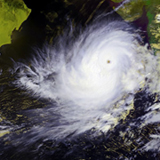
The tropical cyclones in the Arabian Sea during the pre-monsoon season
May – June) have intensified since 1997 compared to 1979 - 1997. This is the result of decreased vertical wind shear due to a 15-day on average earlier occurrence of tropical cyclones and an earllier monsoon onset, according to a study spearheaded by Bin Wang at the International Pacific Research Center, University of Hawaii at Manoa and published in "Brief Communications Arising" in the September 20, 2012, issue of Nature.
Read press release.
NASA’s Martian Weather Reports Reveal Extreme Pressure Swings
September 19, 2012
Curiosity, the NASA rover that landed on Mars last month, is sending us remarkable weather observations from the Martian surface. “The exciting new result from Curiosity is a regular and truly enormous swing in atmospheric pressure through each day. Measurements on Earth show a daily swing in pressure of only about one-tenth of 1% of the mean pressure, whereas Curiosity is measuring swings of almost 10% of the daily average pressure,” says IPRC Director Kevin Hamilton, a pioneer in the area of computer modeling of the Martian atmosphere. “These results confirm a theoretical prediction I made years ago that the daily cycle on Mars could be amplified by a global resonance of the atmosphere.”(read press release)
Climate Change and the South Asian Summer Monsoon
Honolulu, June 25, 2012 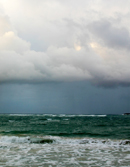
The vagaries of South Asian summer monsoon rainfall impact the lives of more than one billion people. Based on an extensive review of recent research, IPRC’s H. Annamalai and A. G. Turner from the University of Reading in the UK, conclude that with continued rise in CO2 the region can expect generally more rainfall. Regional projections for devastating droughts and floods, however, are still beyond the reach of current climate models. Their review is in the June 24 online edition of Nature Climate Change. Read release.
Unprecedented, Man-made Trends in Ocean's Acidity
Honolulu, January 22, 2012
Recent carbon dioxide emissions have pushed the level of seawater acidity far above the range of the natural variability that existed for thousands of years and are affecting the calcification rates of shell-forming organism, according to a study of an international team of scientists led by IPRC's Tobias Friedrich and Axel Timmermann. Their study appears in the January 22 online issue of Nature Climate Change.
Tsunami Debris Survey Launched Northwest of Midway
Honolulu, January 25, 2012 
The March 11, 2011 earthquake northeast of Japan and the impact of the subsequent tsunami wave on the Tohoku coastline produced as much as 25 million tons of debris. A large amount of the debris was released into the ocean. Under the influence of winds and currents, floating debris is dispersing over a large area and drifting eastward; it is predicted to reach Hawaii and the West Coast of the United States within the coming two years. In order to obtain some certainty about the model predictions, an expedition was made to survey the ocean northwest of Midway during December. Read more about the survey.
Press Releases 2011
Russian Ship Finds Tsunami Debris where Scientists Predicted
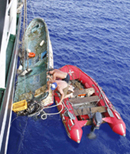
October 13, 2011
Ever since the Japan tsunami on March 11 washed millions of tons of debris into the Pacific, IPRC's Nikolai Maximenko and Jan Hafner have been trying to track the trajectory of this debris that can threaten small ships and coastlines. Until now they had only their state-of-the-art – but still untested – computer model of currents to speculate where the debris might end up. Warned by maps of the scientists' model, the Russian sail training ship, the STS Pallada, found an array of unmistakable tsunami debris on its homeward voyage from Honolulu to Vladivostok. More photos courtesy STS Pallada/Natalia Borodina.
APEC Climate Symposium Hosted by
UHM International Pacific Research Center

October 12, 2011
As part of the 2011 APEC activities in Honolulu, the APEC Climate Center is holding its Annual Symposium at the Keoni Auditorium, East-West Center, from October 17 through 20. Local host for the symposium is the International Pacific Research Center (IPRC), the climate center at the School of Ocean and Earth Science and Technology, University of Hawaii at Manoa.The media and the public are welcome to attend the first 3 days. The program is available at https://iprc.soest.hawaii.edu/meetings/workshops.php. If any media wish to set up interviews with presenters at the symposium, contact:
IPRC Outreach Specialist Gisela Speidel (808) 956-9252; gspeidel@hawaii.edu) or
Assistant Researcher June-Yi Lee (808) 956-7544; jylee@soest.hawaii.edu.
Author of the World Development Report 2010 to Give
 The 2011 IPRC Public Lecture in Climate Science
The 2011 IPRC Public Lecture in Climate Science
October 10, 2011
Climate Change and Development: Avoiding the Unmanageable and Managing the Unavoidable is
the title of this year’s IPRC Public Lecture in Climate Science. The free public lecture will be given by
Rosina Bierbaum, Dean of University of Michigan’s School of Natural Resources and Environment, at 7:00
pm, October 17, at the Art Auditorium, University of Hawaii at Manoa.
University of Hawaii Chosen for New Climate Science Center
October 7, 2011
Secretary of the Interior Ken Salazar announced today the establishment
of the Pacific Islands Climate Science Center, a consortium led by the
University of Hawaii at Manoa, the University of Hawaii at Hilo, and
the University of Guam. The Pacific Islands Climate Science Center will be
part of a network of eight regional centers being established by the
Department of the Interior. The centers will serve to provide land
managers in federal, state and local agencies access to the best
science available regarding climate change and other landscape-scale
stressors impacting the nation’s natural and cultural resources.
El Niño and the Tropical Eastern Pacific Annual Cycle
Run to the Same Beat
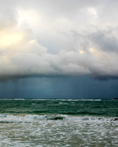
September 21, 2011
The interaction between El Niño events and the seasonal cycle of sea surface temperatures in the eastern equatorial Pacific can be described through a nonlinear phase synchronization mechanism, according to a study published in the September 16 issue of Physical Review Letters by climate scientists at the University of Hawaii at Manoa. The findings are expected to improve prediction of El Nino events.
Russian Tall Ship to Search for Missing Tsunami Debris
September 13, 2011 
Virtually nothing is known of the whereabouts of the tons of debris that were washed into the ocean by Japan's March 11 tsunami. Nikolai Maximenko, who made model projections of the tsunami debris path, has now engaged the Russian 3-master STS Pallada, its Captain
Vasily Sviridenko and young cadets to look out for the debris and report what they see on their homeward journey from Honolulu to Vladivostok.
East Africa’s Climate
Under the Spell of El Niño since the Last Ice Age
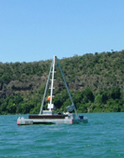
August 4, 2011
The current severe drought in East Africa is being attributed to La Niña conditions that prevailed in the Pacific until May 2011. The waxing and waning of rainfall in eastern tropical Africa in unison with El Niño–Southern Oscillation is not unusual and existed already 20,000 years ago, though the region’s last 3,000 years have seen a less stable climate, according to a study published by an international group of scientists on August 5 in Science.
Tree Rings Tell a 1100-Year History of El Niño

May 6, 2011
Tree-ring records from North America give a continuous history of variations in El Niño intensity over the past 1,100 years and can be used to help climate models predict more reliably how El Niño will change in the face of global warming, according to the study published in the May 6th issue of Nature Climate Change by an international team of scientists led by Jinbao Li, International Pacific Research Center, University of Hawaii.
Where Will the Debris from Japan's Tsunami Drift in the Ocean?
April 6, 2011
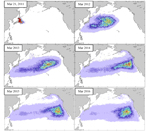 The huge tsunami triggered by the 9.0 Tohoku Earthquake destroyed coastal towns near Sendaiin Japan, washing such things as houses and cars into the ocean. Based on a model derived from past trajectories of drifting buoys, projections of where this debris might head over the next 5 to 6 years have been made by Nikolai Maximenko and Jan Hafner at the International Pacific Research Center, University of Hawaii at Manoa. Click on figure to see animation.
The huge tsunami triggered by the 9.0 Tohoku Earthquake destroyed coastal towns near Sendaiin Japan, washing such things as houses and cars into the ocean. Based on a model derived from past trajectories of drifting buoys, projections of where this debris might head over the next 5 to 6 years have been made by Nikolai Maximenko and Jan Hafner at the International Pacific Research Center, University of Hawaii at Manoa. Click on figure to see animation.
Tropical Atlantic Sees Weaker Trade Winds and More Rainfall
February 6, 2011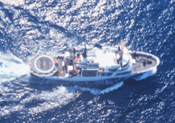 Earth is warming but not evenly. Efforts to pin down regional climate impacts of this warming have been hampered by biased wind observations over oceans. Developing a new technique to remove the bias, scientists at the International Pacific Research Center, University of Hawaii at Manoa, found that during the last 60 years trade winds over the tropical Atlantic have weakened, ocean temperature patterns have shifted, and Amazon and Guinea Coast rainfall has increased. The study by Hiroki Tokinaga and Shang-Ping Xie appears in the online February 6 issue of Nature Geoscience.
Earth is warming but not evenly. Efforts to pin down regional climate impacts of this warming have been hampered by biased wind observations over oceans. Developing a new technique to remove the bias, scientists at the International Pacific Research Center, University of Hawaii at Manoa, found that during the last 60 years trade winds over the tropical Atlantic have weakened, ocean temperature patterns have shifted, and Amazon and Guinea Coast rainfall has increased. The study by Hiroki Tokinaga and Shang-Ping Xie appears in the online February 6 issue of Nature Geoscience.
Press Releases 2010
Study Could Mean Greater Anticipated Global Warming
November 22, 2010 
Global climate models disagree widely in the magnitude of the warming we can expect with increasing carbon dioxide. This is mainly because the models represent clouds differently. A new modeling approach successfully simulates the observed cloud fields in a key region for climate. The study finds a greater tendency for clouds to thin with global warming than in any of the current climate models. This means the expected warming may be greater than currently anticipated. The study by Lauer et al. is published in the Journal of Climate, Vol. 23, No. 21, 5844–5863.
Threshold Sea Surface Temperature for Hurricanes
and
Tropical Thunderstorms Is Rising
November 7, 2010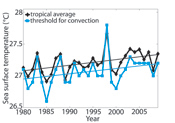
Scientists have known that atmospheric
convection in the form of hurricanes and tropical
ocean thunderstorms occurs when sea
surface temperature rises above a threshold. So how do rising ocean
temperatures with global warming affect this
threshold? If it does not rise, it could
mean more frequent hurricanes. The study by IPRC's Nat Johnson and Shang-Ping Xie shows this
threshold
is rising with global warming at the same rate as
tropical ocean temperatures. Their paper appears in
the Advance Online Publications of Nature Geoscience.
UH Scientist Predicts Plastic Garbage Patch in Atlantic Ocean
August 19, 2010
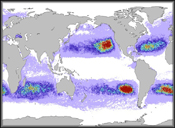 Where does the plastic garbage in the ocean go? Twenty-two years worth of data collected by undergraduate students aboard a sailing vessel has identified widespread floating plastic debris in the western North Atlantic that
is comparable to the ‘Great Pacific Garbage Patch.’ The study, led by a team of researchers from Sea Education Association (SEA), Woods Hole Oceanographic Institution (WHOI), and the University of Hawaii at Manoa (UHM), is published this week in Science.
Where does the plastic garbage in the ocean go? Twenty-two years worth of data collected by undergraduate students aboard a sailing vessel has identified widespread floating plastic debris in the western North Atlantic that
is comparable to the ‘Great Pacific Garbage Patch.’ The study, led by a team of researchers from Sea Education Association (SEA), Woods Hole Oceanographic Institution (WHOI), and the University of Hawaii at Manoa (UHM), is published this week in Science.
The North Pacific, a Global Backup Generator
for Past Climate Change
July, 9, 2010
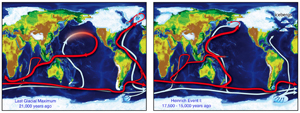 Toward the end of the last ice age, a major reorganization took place in the current system of the North Pacific, which may have buffered the global impacts of the collapsed circulation in the Atlantic, according to a study published by Yusuke Okazaki (JAMSTEC), Axel Timmermann (IPRC) and their international team in the Science. For press release.
Toward the end of the last ice age, a major reorganization took place in the current system of the North Pacific, which may have buffered the global impacts of the collapsed circulation in the Atlantic, according to a study published by Yusuke Okazaki (JAMSTEC), Axel Timmermann (IPRC) and their international team in the Science. For press release.
Going After Regional Climate Patterns
of Global Warming
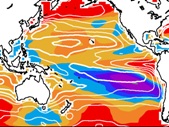 February 27, 2010
February 27, 2010
Ocean surface temperatures can be expected to increase mostly everywhere by the middle of the century, but the increase may vary by up to 1.5 C depending upon the region. These emerging ocean temperature patterns in the tropics and subtropics will lead to significant changes in rainfall patterns, according to work by IPRC's Shang-Ping Xie and colleagues.
News Archive: 2013, 2012, 2011, 2010, 2009, 2008, 2007, 2006, 2004, 2003, 2002, 2001, 2000


